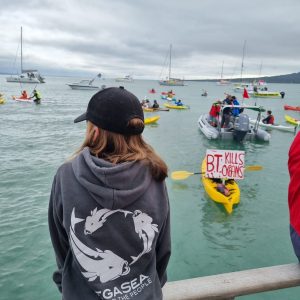As we lurch our way into the silly season it is only natural that our thoughts turn to fishing and diving for the delicacies we have dreamt about all year. Crayfish is on the top of many people’s wish list, to say thanks to someone special, for sharing with the whanau or as a holiday treat. Treasure your thoughts because in many parts of Aotearoa depletion means they will remain just that, dreams.
Currently we have a statutory body that directs the crayfish science and management processes, it then provides advice to the Minister on catch settings. Members of the National Rock Lobster Management Group are appointed by the Minister and none of the current members report to us, the public, on what goes on behind closed doors. Without public scrutiny, management and policy advice since the 1990s has descended to new lows.
For example, in two South Island areas and the Gisborne to East Cape area commercial fishers are permitted to take crayfish smaller than what we can take, below the minimum legal size. And despite being a valuable quota species we don’t know how many undersized fish are taken because the numbers are not reported publicly.
Further north, in the Hauraki Gulf and eastern Bay of Plenty, the CRA 2 stock became so depleted that professional harvesters were dropping almost 600,000 pots per annum and still they couldn’t catch their allowable limit. Some sanity now prevails.
Thanks our collective effort the Minister cut the CRA 2 Total Allowable Commercial Catch (TACC) by 60% on April 1st. This ought to translate into fewer crayfish pots around inshore areas close to your holiday spot this summer.
Earlier this year LegaSea was pushing for a total closure of CRA 2 so that it could rebuild with no disturbance from humans, after all we are the problem.
Management is also a problem because it lacks any nuance. The TACC has been cut by 60% and the overall recreational allowance has been reduced by 76%. A review is underway now to consult on halving the daily bag limit and introducing telson clipping to identify recreational catch. We will support the bag limit reduction in the interests of rapidly rebuilding the crayfish stock, but the rationale for telson clipping is emotive and driven by commercial interests rather than evidence-based.
Altering catch and bag limits for crayfish across large and diverse areas creates an illusion that this is an appropriate management strategy while ignoring the local area and broader governance issues of leadership and policy. And at ground level we cannot continue with the charade that a statutory body is representative of public interests when the Minister struggles to fulfil his statutory obligations to provide for the foreseeable needs of future generations.
If we are to realise the full potential from our fisheries and give ordinary Kiwis a fair crack at gathering a crayfish for that special occasion we must do better. The status quo is not acceptable.





